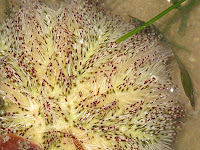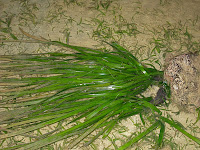














Today, I ventured into Terumbu Pandan, which is the largest of the three submerged reefs that are collectively called Cyrene Reefs. We assembled at 4:30am at Keppel Bay Marina and took a chartered boat out to the reef amidst the bright lights of Pulau Bukom and Jurong Island. The tide was exceptionally low today at 0.0m, so the landing wasn't as amphibious as I thought it would be. Once we set foot on the reef, I realised that it was truly quite extensive with a huge sandbar cutting across the reef. To one side lies the lush sea grass meadow, while the other is a rocky outcrop consisting of coral rubble, live coral and live rocks.
The interesting thing about Cyrene is the fact that it lies right smack in the middle of the so-called 'Industrial Triangle'. To the south-east lies Pulau Bukom oil refinery which shines like a jewel in the night. To the right lies Jurong Island which houses some of the world's largest chemical and petro-chemical plants. To the north of the reef lies various shipyards including Keppel, PPL and ASL, and the container ports at Jurong Port and Pasir Panjang container terminal. As this is a major container shipping lane, a few hundred vessels consisting of a good mix of container, LNG, bulk carriers, offshore supply vessel, anchor handling tugs and cruise liners ply the waters around the reef every day. It is therefore truly astounding and fortunate that amidst these live threats, we have a reef that is so rich in biodiversity.
When the tide is at its lowest, and at first light, one can truly marvel at the extent and size of this reef. It's truly surreal to be standing in the middle of all basking in the rays of the rising sun, against the backdrop of the heavy industries in the distance and being nonchalant about the large vessels just sailing by. One can't help but wonder, "Am I in Singapore?












Cyrene supports a flourishing colony of fish and invertebrate. Especially common are the knobbly stars, the common star, an assortment of sea cucumbers, an array of crabs (swimming, egg, hairy, reef) and the sand-dollar. I didn't get to see very much in the way of fish, other than this small butterfly hiding in a small rock pool. Others were far luckier as they got to see scorpion fish, long-horned cowfish, sole, wrasse, blue-spotted ray, goatfish and various types of filefish. I'll have to start opening my eyes more during the next trip.
I got to see quite a lot of coral but unlike the Sisters Island, bleaching at Cyrene seems to be more prevalent. Quite a lot of the larger brain coral, anchor coral, galaxy coral, table coral and the leather corals were bleached, particularly those found at the southern and western tip of the reef. There was also a noticeable stench and murkiness in that area, which I believe is caused by the dying coral. Thankfully, not all the coral was bleached. The favid boulder coral still retained its bright lime green colour while the soft cauliflower coral (Dendronephthya) looked pretty much alive and in the pink of health.
Here are some of the corals which have bleached.






There are quite a few fish traps in Cyrene. Initially, I thought they were abandoned traps because they looked old and some were even damaged. I realised from others who went on later trips that these were very much live traps and all sorts of fish such as blue spotted fan rays, batfish, anchor tusk fish, oriental sole etc were found in these traps. Ria would prefer that we free the fish we find and if possible, destroy or trample of these traps.


And finally, here are the creatures which inhabit Cyrene.



























Apart from the marine life at Cyrene, the other thing which is worth sacrificing sleep and making the trip are the gorgeous sunrises. I can't wait for my next trip to Cyrene.
No comments:
Post a Comment